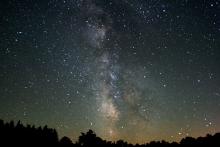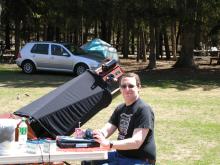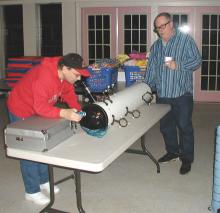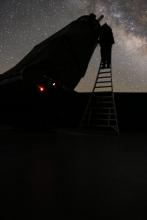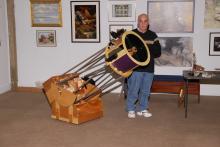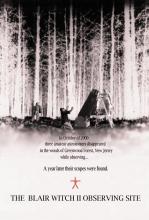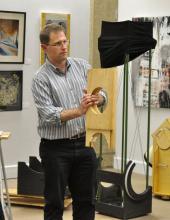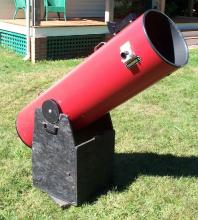This is a no-spin attempt to clarify false or exaggerated information from those representing opposite sides of the LP issue.
Article for Astronomers
EVERYONE BENEFITS WHEN LIGHT POLLUTION IS REDUCED
Some Amateur Astronomers have contacted their local and state officials about light pollution, mainly emphasizing sky glow and its impact on observing the night sky. This approach, calling for dark skies, has had but limited positive effect in New Jersey and some other parts of the country. Much broader approaches exist, with wider resonance and appeal, that can still provide the result astronomers want: darker skies.
What is light pollution?
I'd like to share some of our experiences here in Eatontown, NJ, in controlling LP from a somewhat different approach; but first lets define LP. The Illuminating Engineering Society of North America (IES) defines LP basically as: "sky glow". Bear in mind though, that the same misdirected or excessive outdoor lighting that causes most sky glow can also cause glare, light trespass, and energy waste. The IES treats these other adverse effects of misdirected or excessive lighting as separate problems. In 1996, the NJ Light Pollution Study Commission broadened the definition to include all of the above adverse components.
Emphasize dark skies?
The Eatontown ordinance was adopted in 1993 and contains no reference to astronomy or dark skies. It does say that the purpose of the ordinance is to control glare, light trespass (nuisance light), energy waste and unnecessary sky glow. Local officials felt that the reference to reducing sky glow was sufficient for those interested in dark skies. Some people think of "dark skies" in a negative kind of way making them feel insecure. Of the dozen lighting ordinances adopted in NJ, only one that I'm aware of was primarily influenced by astronomy concerns. Astronomers lobbying for dark skies represent less than one percent of the States population. In my opinion, most municipal and state officials would prefer to keep their distance from any special interest group pushing a narrow agenda such as dark skies. Instead, they want to be perceived as satisfying the majority of their constituents by providing them with a broad range of lighting improvements that would be made by controlling light pollution.
When the Bill to form the New Jersey State Commission was first forwarded to Governor Jim Florio for signature, he did not sign it (a pocket veto), because he felt that it would only "benefit astronomy". His aids said that the letters he received in support of the Bill mainly emphasized the need for dark skies. When the Bill was resubmitted to him the following year, he almost didn't approve the Bill again, until he was made aware that everyone would benefit by controlling LP.
Why is there still so much light pollution?
With well over 500 municipalities in NJ, why are so few controlling LP? The State Commissions recommendations were quite clear: Light pollution can be reduced, a benefit to everyone. But those Departments of State and the major electric utilities that were included in the State Commission's membership, have not really followed their own representative's recommendations. Light pollution is still a very misunderstood issue and most people don't realize that anything can be done about it.
It's time for no spin
Media coverage has generally presented the light pollution issue from an astronomy perspective. Most people interviewed have been from the astronomy sector clearly and passionately expressing their inability to view the night sky. Even though some other elements of light pollution are mentioned, the astronomy concerns usually dominate in the articles. Often, inaccurate, or partial technical information is accepted as being complete and factual causing confusion and sometimes inappropriate action from those on opposite sides of the issue. Here are some samples of inaccurate information.
- Streetlighting
- If you use cutoff streetlights you will be able to reduce the lamp wattage and save energy.
- Using cutoff streetlights will require closer spacing increasing cost and energy use.
Both of these statements are not true. We asked Cooper Lighting to prepare a photometric grid of three cobra head fixtures, on a typical residential street 30 feet wide, at 30 foot mounting heights, all with the same 70 watt HPS lamp. One fixture had a drop lens (non-cutoff), The second a flat lens (full cut-off) and the third a sag lens (cutoff). To meet IES average illuminance recommendations the drop lens fixture actually had to be spaced even closer than the cutoff types. Reducing lamp wattage would have brought the illuminance below IES recommended levels. We found similar comparisons with decorative post top streetlights as well. Over-all, I would rate the comparison between cutoff and non-cutoff a draw. However, by reducing even low levels of unnecessary glare with the cutoff fixtures, we all see better (and it will reduce sky glow ).
- If you use cutoff streetlights you will be able to reduce the lamp wattage and save energy.
- Parking Lots
- Mandating cutoff type light fixtures over non-cutoff will increase cost.
Here again, overall cost is about the same. Efficient light fixtures with good uniformity should be the choice. High priced fixtures may not be as good as less expensive ones. The photometric grid ordinance requirement showing illuminance points every 10 feet will help the designer to choose effectively. Some manufacturers may even prepare a grid for the local engineer.
- Restricting pole heights to 16 feet or lower, will reduce light pollution.
For small parking lot lighting, 16 feet may be the perfect height, but larger lots would require more light fixtures mounted on such 16 foot poles. For larger sized parking lots requiring greater mounting heights, light pollution will not be increased over the use of shorter poles. In fact it can increase cost and even use more energy. For a mid to large sized parking lot requiring 30 foot mounting heights, reducing the height to 15 feet could increase the number of poles needed about 4 times to light the same area (inverse square rule). Even though one 400 watt lamp could equate to four 100 watt lamps, the lumen per watt ratio is usually better for the higher wattage lamp, thereby saving energy.
- Low pressure sodium (LPS) lamps are the most energy efficient and should be used for all street and parking lot lighting.
It is important to use LPS lamps in areas that include major astronomical observatories, allowing astronomers to filter out the narrow yellow color wavelength form of sky glow. These special filters, however, are really not available to amateur astronomers. The LPS monochromatic light does not provide any color rendition unless other "white" light is added. All colors appear as varying shades of greyish brown. Also, vision reaction time at low LPS levels is slower than with other lamp source lighting. I see no benefit to anyone in NJ, including amateur astronomers, in a LPS lighting mandate.
- Illuminance Levels
- Lighting illuminance should be the minimum adequate for the intended light task.
This type of wording, requiring only minimum illuminance levels, can be misunderstood to mean that a municipality might be denied reasonable light levels that they're entitled to. The IES has one set of parking lot average illuminance recommendations that fall between 1.0 fc (Basic) and 2.5 fc (Enhanced Security). Eatontown allows a business to choose a level anywhere within this range and after business hours many lights are turned off. This has been met with both business and public approval. Many fast food restaurants elsewhere average as high as 20 fc and shopping malls can reach averages of about 10 fc or more. Often, these lights are left on from dusk to dawn.
- Security lighting
- There is no conclusive evidence so far that lighting prevents crime.
- For after business hour security lighting, no lighting works best.
Such wording may be included in some studies, but many times it is taken out of context. These same studies also state that more investigation is needed for a final verdict. There certainly still is crime in lighted areas, but studies reviewed by the NJ State Commission have indicated that in lighted pedestrian walkway areas, light provides the ability to see ahead and take evasive action (by crossing the street, etc.) to avoid passing close to suspicious persons. In another study, there were more unoccupied automobile break-ins in lighted areas than low or non-lighted. In some places there might even be more crime during daylight hours than at night. Most people prefer lighting to feel safer, but it should be at an effective level, not excessive or glary.
Some parts of the Country have reported that shutting off all lights during off-hours has significantly reduced vandalism, however, this may not work for everyone. The IES recommends reducing the lighting to a much lower level during this period. Motion sensor lighting can also be very effective by acting as a visual alarm attracting attention.
- There is no conclusive evidence so far that lighting prevents crime.
- Electric Utility Floodlights
Here are some excerpts from floodlight promotional literature:
"...a well designed floodlighting system; ...a crime free zone; ...safety and security every night of the year; So rest easy; Peace of mind."
Such statements of assurance made by the Utilities are not realistic and should not be made. Unfortunately, many of these floodlights are not installed properly throughout the State and spill light well outside the intended parking lot area. In some cases the lamp wattage is too high. When aimed incorrectly, such lights cast glare into the vision range of motorists that can be distracting and even hazardous. When Eatontown adopted its lighting ordinance, 120 of these floodlights were already installed in the Borough. Many were repositioned or had external visors added to control the glare. We are still waiting for a few more that still need adjustment or replacement. The state of Connecticut has recently passed a law that requires proper installation to avoid glare. The Eatontown Lighting Ordinance now includes similar controls. the Long Island Power Authority in New York, has replaced their floodlight service with a full cutoff light fixture. Perhaps New Jersey and other states should do the same.
The best approach for light pollution controls
Here again, light pollution affects everyone and controlling it will benefit everyone. This broad concept has worked very well in Eatontown. Your municipal officials may not be familiar with the IES illuminance recommendations and showing them that these lighting levels are more than adequate for safety and security, can be quite effective. For those living nearby, the Eatontown lighting tour could be helpful in demonstrating how visibility and a feeling of safety can be achieved with the right kind of lighting. We still have some "old grandfathered" glary and excessive lighting examples left as well, that show the dramatic difference between good and bad lighting. Using dark skies as the primary reason for adopting an ordinance has worked well in some parts of the country, however, in other parts it can be more of a liability than an asset. California has excellent roadway lighting, but the same cannot be said of all its business lighting. In 1999, Laverne Booth of the IDA Los Angeles Section, said "Southern California Edison is running radio commercials which imply that if you can see thousands of stars, there are burglars lurking in your yard to break into your house. Their current TV commercials and billboards state that a dark yard is a welcome mat for burglars. Now we hear that Pacific Gas and Electric is running similar commercials." In Tucson Arizona, business owners wanted to increase light levels three times above the ordinance cap, claiming safety concerns. Perhaps pushing too hard for dark skies can sometimes cause a counter reaction, or even apathy.
In my opinion, emphasizing the many benefits other than astronomy might be the best approach for establishing light pollution controls. Some Astronomers I have talked with have been unwilling to try such an approach, answering: "but that's who we are". It is also important to be accurate when writing to or talking with local and state officials avoiding the kind of misleading statements shown above, otherwise your credibility will be challenged and your efforts may be wasted. The IES recommends using cutoff lights for roadways, parking lots and directional control for many other uses. This will confine light to the intended target area without spilling it in unwanted directions. The amount of light should also be the optimum levels that they recommend, not too dim and not too bright. Following these guidelines will avoid glare and excessive light, will improve visibility and safety without wasting energy and may be the most persuasive argument for everyone to accept. All of these things will also significantly reduce sky glow.
By John Batinsey - Revised May 2006
John Batinsey is currently a member of the Eatontown, NJ Environmental Commission. He was a member of the NJ Light Pollution Study Commission and served as Chairman. This State appointed Commission submitted its report to the Governor and Legislature in April, 1996.

